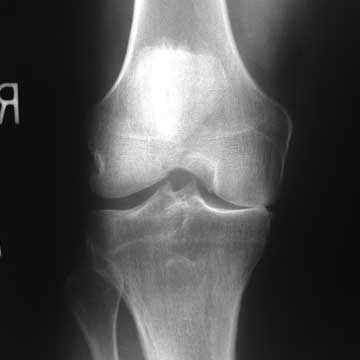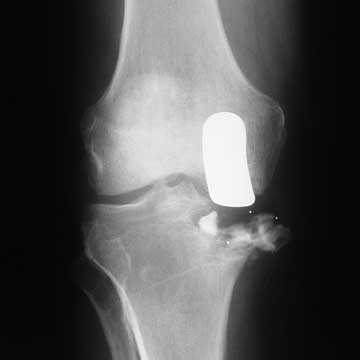|



|
synonyms:uni, unicompartmental knee replacement, partial knee replacement, unicompartment knee arthroplasty
Unicompartment Knee Arthroplasty CPT
Unicompartment Knee Arthroplasty Indications
- Primary indication is anteromedial knee ostoearthritis.
- Unicompartmental OA, radiographic evidence of preservation of opposite compartment, only mild PF DJD
- Primary spontaneous osteonecrosis (secondary AVN, ie steroid use, is a contraindication
- ROM>90 degrees
- Flexion contracture <5°, angular deformity <15°.
- Minimal pain at rest
- Relatively sedentary lifestyle
- Weight <275 lb (124.7kg)
- Age >50y/o.
Unicompartment Knee Arthroplasty Contraindications
- Opposit compartment athritis
- Lateral facet patellofemoral arthritis with bone on bone contact, grooving, patellar subluxation
- Fixed varus or valgus deformity >5°
- Restricted ROM
- Fixed flexion contracture
- Joint subluxation >5mm
- ACL deficiency
- MCL deficiency
- Inflammatory arthritis
- Hemochromatosis
- Chondrocalcinosis
- Hemophilia
- Symptomatic instability
Unicompartment Knee Arthroplasty Alternatives
- Arthroscopic debridement-indicated for pt with ,1yr symptoms, normal alignment, mechanical symptoms.
- Distal Femoral osteotomy
- TKA
- High Tibial osteotomy
- Arthodesis-indicated for infection, failed TKA, young active patients, soft tissue defects, absent extensor mechanism, neuropathic joint disease. fusion in 10-15 flexion and 0-7 valgus. complications=infection, non/malunion, pain.successful in 80-90% of failed condylar components, 55% of failed hinged prosthesis.
Unicompartment Knee Arthroplasty Pre-op Planning
- Shorter hospital stay, fewer serious complications, improved walking ability, lower cost, more normal gait, better quadriceps function, better knee flexion than TKA
- Arthritis progresses in other compartments which may limit long long-term outcome. Often must deal with bone deficiency in revision to TKA
- Goal = undercorrection of the mechanical axis by 2° -3° .
- Do not release MCL and allow 2mm of joint laxity in extension and flexion.
- Recreate native tibial slope.
- Femoral component should be placed perpendicular to the tibial component in the coronal plane.
Unicompartment Knee Arthroplasty Technique
- Sign operative site.
- Pre-operative antibiotics, +/- regional block.
- General endotracheal anesthesia
- Supine position. All bony prominences well padded.
- Examination under anesthesia.
- Prep and drape in standard sterile fashion.
- Irrigate.
- Close in layers.
- femoral component should be congruent with the curvature of the anterior part of the femur to avoid patellar impingement.
- Pre-drill any holes for alignment guides to avoid subsequent tibial plateau fx
- avoid over correcting any alignment deformity to decrease progressive arthritis in adjacent compartment
Unicompartment Knee Arthroplasty Complications
- Lateral Compartment arthritis progression
- Poly dislocation
- Pain
- Loosening
- Wear
- Patellofemoral pain / arthritis (rare)
- Tibial plateau fracture
- Medial collateral ligament avulsion/tear
- Stiffness
- Infection
- CRPS
- DVT / PE
- ACL rupture (related to posterior tibial slope 7°)
Unicompartment Knee Arthroplasty Follow-up care
- Post-op:
- 7-10 Days:
- 6 Weeks:
- 3 Months:
- 6 Months:
- 1Yr:
- It is not uncommon for patients to have some medial proximal tibia or knee pain for the first 6-12 months post op. This generally resolves with observation and conservative care.
Unicompartment Knee Arthroplasty Outcomes
- Miller-Galante UKA system, modular fixed-bearing, metal-backed tibial component (Zimmer) 80% excellent, 12% good, 8% fair results. 98% survival rate at 10 years (Berger RA, JBJS AM 2005;87:999-1006)
- Oxford, meniscal-bearing UKA system 93% 15 year survival, 91% good/excellent clinical results (CORR 2005;435:171).
- Failure occurs from wear, loosing, and adjacent compartment degeneration.
- Decreased survivorship for UKA than TKA.
- No differences in survivorship between fixed- or mobile-bearing UKAs.
- Mobile-bearing UKA have 1% risk of bearing spinout.
- UKA has higher revision rate, shorter hospital stay, lower perioperative complications when compared to TKA (Bolognesi MP, JBJS 2013;95:2049)
Unicompartment Knee Arthroplasty Review References
- Iorio R, JBJS 2003:85:1351°
- W-Dahl A, Robertsson O, Lidgren L, Miller L, Davidson D, Graves S. Unicompartmental knee arthroplasty in patients aged less than 65. Acta Orthop. 2010 Feb;81(1):90-4. doi: 10.3109/17453671003587150.
- Borus T, JAAOS 2008;16:9
- Goodfellow J, O’Connor J, Dodd C, Murray D, eds. Unicompartmental Arthroplasty with the Oxford Knee. Oxford, UK: Oxford Medical Publications; 2006.
- Murray DW, Goodfellow JW, O'Connor JJ. The Oxford medial unicompartmental arthroplasty: a ten-year survival study. J Bone Joint Surg Br. 1998 Nov;80(6):983-9.
|



